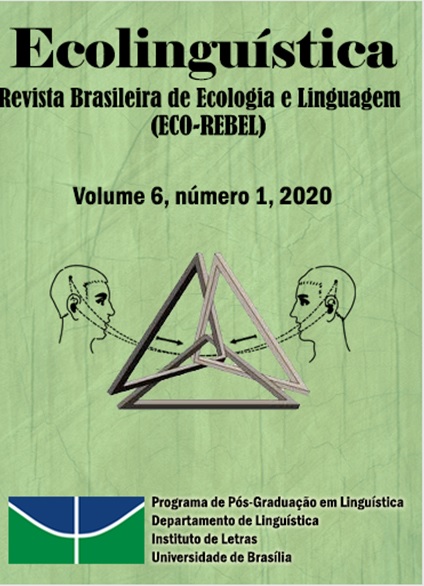El translenguaje digital, estrategia discursiva ecológica de jóvenes bilingües quechua ”“ castellano en Facebook y whatsapp
Abstract
Indigenous languages ”‹”‹in Bolivia are vulnerable in digital social networks. Despite their recognition and officialization, their face-to-face and digital use in everyday interactions are restricted to the adult population and to small and intimate areas. Digital social networks constitute a new relational scenario for young people of Quechua origin who experience new forms of communication through a multimodal language that forces the Quechua language to fight its displacement and resist the onslaught by Spanish and English. From the digital ethnography of speech as a qualitative method that involved the application of techniques such as digital observation, interview and linguistic autobiography, the article shows how young schoolchildren from two provinces of the Department of Cochabamba, Bolivia, develop a translanguage that combines and complements the use of Quechua and Spanish languages ”‹”‹in their digital interactions on Facebook and WhatsApp. Contrary to what is stated by classical linguistic theory ”“ alternation, code mixing and interference as a reflection of the imperfections of bilingualism ”“, in this article we propose that translanguage constitutes an ecological discursive strategy that reflects the mastery of the languages ”‹”‹that are part of the comprehensive linguistic repertoire of bilingual speakers, their complementary use skills and the rules of interaction and interpretation in digital interactions based on communication needs, interlocutors, conversation topics and communicative intentions.
Downloads
References
BAKER, C. Fundamentos de educación bilingüe y bilingüismo. Madrid: Cátedra, 1997.
Calvet, J.-L. Le marché aux langues. Les effets de la mondailisation. Paris: PLON, 2002.
Calvet, J.-L. Quels fondements pour une écologie des langues? Ecolinguística: Revista Brasileira de Ecologia e Linguagem (ECO-REBEL), v. 2 n. 2, 2016, p. 19-35.
CASTELLS, M. La sociedad red (Vol. I). Madrid: Alianza, 2006.
CHOMSKY, N. (2011). Language and Other Cognitive Systems. What Is Special About Language. Language Learning and Development. London: Routledge, 2011, pág. 263-278.
COUTO, H. Ecolinguistica: estudos das relacoes entre lingua e meio ambiente. Brasilia: Tessaurus, 2007.
COUTO, H. Linguística ecossistêmica: um novo modo de estudar os fenômenos da linguagem. In COUTO, E.; DOURADO, Z.; SILVA, A.; AVELAR, J. (Comp.). Linguística ecossitêmica. 10 anos de ecolinguística no Brasil. Campinas: Pontes Editores, 2017, p. 21-43.
COUTO, H. Ecolingüística. In: ARRATIA, M.; Limachi, COUTO. (Comp.). Construyendo una sociolingüística del sur. Reflexiones sobre las culturas y lenguas indígenas de América Latina en los nuevos escenarios. Cochabamba: CIPROEIB Andes/Kipus, 2019, p. 145-166.
CRYSTAL, D. La revolución del lenguaje. Madrid: Alianza, 2005.
FILL, A., & MÜHLHÄUSLER, P. Ecolinguistics reader. London: Continuum, 2001.
FISHMAN, J. What do you Lose When you Lose Your Language? In: Fishman, J. Stabilizing Indigenous Languages. Arizona: Arizona University, 1996, p. 71-81.
GARCÍA, O. El papel del translenguar en la enseñanza del español en los Estados Unidos. In: DUMITRESCU, D. G. P. (comp.). El español en los Estados Unidos: e pluribus unum? enfoque multidisciplinar. Nueva York: Academia Norteamericana de la Lengua Española, 2013, p. 353-37).
GUGENBERGER, E. (1995). El conflicto lingüístico: el caso de los quechuahablantes en el sur del Perú . In: K. Z. (comp.). Lenguas en Contacto en Hispanoamércia: nuevos enfoques. Frankfurt/Madrid: Vervuert/Iberoamérica, 1995, p. 181-201.
HINE, C. Etnografía virtual. Barcelona: UOC, 2004.
HORNBERGER, N.; CORONEL-MOLINA, S. M. Quechua Language Shift, Maintenance and Revitalization in the Andes: The Case for Language Planning. International Journal of the Sociology of Language v. 167, 2004, p. 9-67.
HUTCHBY, I. Conversation and Technology. From the Telephone to the Internet. Cambridge: Polity Press, 2001.
HYMES, D. Modelos de la interacción entre lenguaje y vida social. En L. Golluscio, Etnografía del habla. Textos fundacionales. Buenos Aires: EUDEBA, 2002, p. 55-89.
INE. Censo NAcional de Población y vivienda. Principales resultados. La Paz: INE, 2013.
IPELC. Revitalización lingüística. Nidos bilingües. Documento conceptual. Santa Cruz de la Sierra: IPELC, 2017.
MATRAS, Y. Language contact. Cambridge: Cambridge University Press, 2019.
Moreno, F. Adquisición de segundas lenguas y sociolingüística. Revista de Educación v. 343, 2007, p. 55-70.
SILVA, A. A criação de simulacros sobre o ecossistema linguístico: A comunicação virtual em jogos de RPG e MMORPG. Ecolinguística: Revista Brasileira de Ecologia e Linguagem (ECO-REBEL) v. 3, n. 2, 2017, p. 49-68.
https://periodicos.unb.br/index.php/erbel/article/view/9679
PINK, S.; HORST, H.; POSTILL, J.; HJORTH, L.; LEWIS, T.; TACCHI, J. Etnografía digital. Principios y práctica. Madrid: Morata, 2019.
SIGUÁN, M.; MACKEY, W. F. Educación y bilingüismo. Madrid: Santillana/Unesco, 1986.
SKUTNABB-KANGAS, T. Dereitos humanos linguísticos na educação para a manutenção da lingua. Ecolinguística: Revista Brasileira de Ecologia e Linguagem v. 5, n. 2, 2019, p. 25-39.
https://www.periodicos.unb.br/index.php/erbel/article/view/27660
STRINGER, D. Quando Gafanhoto significa relâmpago: como o conhecimento ecológico é codificado nas línguas ameaçadas. Ecolinguística: Revista Brasileira de Ecologia e Linguagem v. 4, n. 2, 2018, p. 41-48.
https://periodicos.unb.br/index.php/erbel/article/view/12361/10826
TERBORG, R.; GARCÍA, L. Muerte y vitalidad de las lenguas indígenas y las presiones sobre sus hablantes. México: CELE UNAM, 2011.
TUSÓN, J. Los prejuicios lingüísticos. Barcelona: Octaedro, 1997.
Downloads
Published
How to Cite
Issue
Section
License
Authors who publish in this journal agree to the following terms:
Authors retain copyright and grant the journal the right of first publication. The work is simultaneously licensed under the Creative Commons Attribution License allowing the sharing of the work with acknowledgment of the authorship of the work and initial publication in this journal.
Authors are authorized to enter into additional contracts separately for non-exclusive distribution of the version of the work published in this journal (e.g., publishing in institutional repositories or as book chapters), with acknowledgment of authorship and initial publication in this journal.
Authors are allowed and encouraged to post and distribute their work online (e.g., in institutional repositories or on their personal page) at any point before or during the editorial process, as this can bring about productive revisions as well as increase impact.
Citation of published works (See The Effect of Free Access).



3.png)



